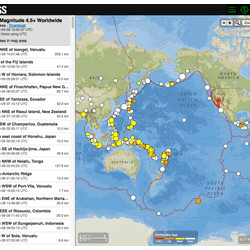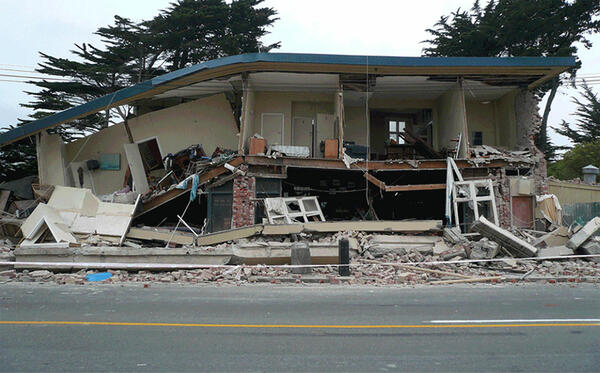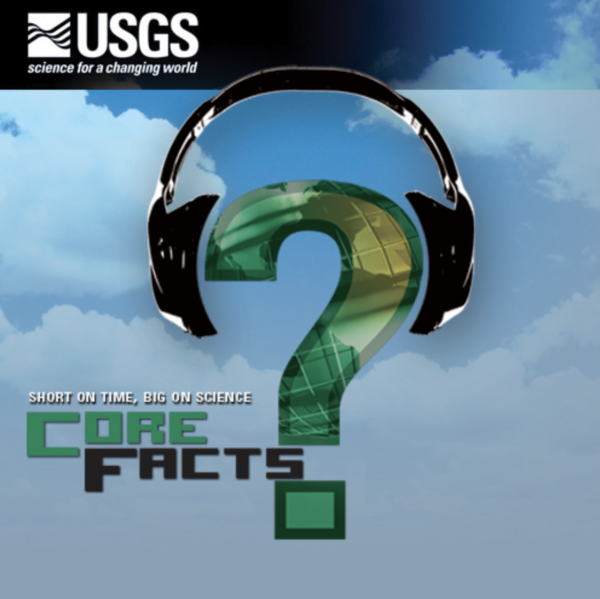Building damanged by the February 2011 earthquake in Christchurch, New Zealand.
Did I feel an earthquake? Can I report feeling an earthquake?
Report an earthquake experience or related observation through the Did You Feel It? citizen science webpage.
The best way to do this is to click on the earthquake that you think you felt on one of the lists on the Earthquakes webpage, and then select the "Tell Us!" link.
If you don't see the earthquake you think you felt, use the green "Report an Unknown Event" button on our Did You Feel It? page. Maps and graphs are produced from the responses in real-time.
Related
Where can I find current earthquake lists and maps for the world or for a specific area? Where can I find current earthquake lists and maps for the world or for a specific area?
The Earthquake Hazards Program Latest Earthquakes Map displays earthquakes in near-realtime and up to the past 30 days of earthquakes. The interface includes three panels: a list of earthquakes, a map, and a settings/options panel. You can pan and zoom the map to view specific areas. Click on an event on the list or map for additional information and a link to the event page with all the details...
Why is the earthquake that was reported/recorded by network X, or that I felt, not on the Latest Earthquakes map/list? Why is the earthquake that was reported/recorded by network X, or that I felt, not on the Latest Earthquakes map/list?
The USGS Latest Earthquakes map and lists show events that have been located by the USGS and contributing agencies within the last 30 days. They should NOT be considered complete lists of all events in the U.S. and adjacent areas and especially should NOT be considered complete lists of all magnitude 4.5 and greater events that occur around the globe. In most cases, we locate and report an...
Why do some earthquakes disappear from the map/list? Why do some earthquakes disappear from the map/list?
The USGS and networks contributing to the Advance National Seismic System (ANSS) take great effort to provide accurate and timely earthquake information. Occasionally our systems produce erroneous information that is released to the public via our web pages or Earthquake Notification System. These mistakes are generally promptly identified by seismologists, removed from our web pages, and “delete”...
Why isn't the fault on which the earthquake occurred or the distance to the nearest fault provided? Why isn't the fault on which the earthquake occurred or the distance to the nearest fault provided?
Seismologists evaluate the hypocenter location and the focal mechanism of an earthquake to decide if the earthquake occurs on a named fault. Research shows that many earthquakes occur on small, un-named faults located near well-known faults. For example, most of the aftershocks of the 1989 M6.9 Loma Prieta earthquake occurred on small, subsidiary faults within a few hundred meters of the mainshock...
Can I get on a list to receive an email message when there is an earthquake? How do I sign up for earthquake notifications? Are there any Feeds I can subscribe to? Can I get on a list to receive an email message when there is an earthquake? How do I sign up for earthquake notifications? Are there any Feeds I can subscribe to?
Please go to the USGS Earthquake Notification Services (ENS) to sign up for free emails or text messages to your phone. Use the default settings or customize ENS to fit your needs. Also check out the many different Earthquake Feeds. ENS is NOT an earthquake early warning system. Messages issued by ENS will almost always arrive after you would feel any shaking. Learn more: How do I sign up for...
Why/When does the USGS update the magnitude of an earthquake? Why/When does the USGS update the magnitude of an earthquake?
The USGS often updates an earthquake's magnitude in the hours and sometimes days following the event. Updates occur as more data become available for analysis and more time-intensive analysis is performed. Additional updates are possible as part of the standard procedure of assembling a final earthquake catalog. There are physical and operational constraints on how quickly seismic data are...
Why do so many earthquakes occur at a depth of 10km? Why do so many earthquakes occur at a depth of 10km?
Ten kilometers is a "fixed depth." Sometimes data are too poor to compute a reliable depth for an earthquake. In such cases, the depth is assigned to be 10 km. Why that number? In many areas around the world, reliable depths tend to average 10 km or close to it. For example, if we made a histogram of the reliable depths in such an area, we'd expect to see a peak around 10 km. So if we don't know...
How quickly is earthquake information posted to the USGS website and sent out via the Earthquake Notification Service (ENS) and other feeds? How quickly is earthquake information posted to the USGS website and sent out via the Earthquake Notification Service (ENS) and other feeds?
USGS earthquake information mechanisms are all triggered by the same system, so they all receive the information at the same time. The time it takes for the system to receive the information primarily depends on the size and location of the earthquake: An earthquake in California is processed and posted to the system in 2.5 minutes (on average). This is because our seismic network is very...
Where can I see current or past seismograms? Where can I see current or past seismograms?
The USGS Earthquake Hazards Program has helicorders (seismogram displays) available for several areas in the United States and the World. Our research partner IRIS (Incorporated Research Institutions for Seismology) has two applications, the Station Monitor and the Global Seismogram Viewer, for viewing seismograms. IRIS also supplies software that allows users to collect and view seismic data from...
Why do USGS earthquake magnitudes differ from those published by other agencies? Why do USGS earthquake magnitudes differ from those published by other agencies?
Magnitude estimates for a given earthquake can vary between reporting agencies due to differences in methodology, data availability, and inherent uncertainties in seismic data. Individual agencies use magnitude estimation procedures designed to meet the agency's specific needs and monitoring capabilities. Even for well-recorded events, differences in magnitude of 0.2 or 0.3 units are common and...
What is UTC, and why do you report earthquakes in UTC? What is UTC, and why do you report earthquakes in UTC?
UTC stands for Coordinated Universal Time, and for this purpose is the same as GMT (Greenwich Mean Time). Since the USGS and other seismic network agencies record earthquakes around the globe in all the various time zones, using a single standard time reference is best for record-keeping and exchange of data. The individual event pages with details about each earthquake use UTC for the reference...
Building damanged by the February 2011 earthquake in Christchurch, New Zealand.
What is the difference between intensity scales and magnitude scales?
What is the difference between intensity scales and magnitude scales?Listen to hear the answer.

A map of ShakeOut scenario shaking in southern California
A map of ShakeOut scenario shaking in southern CaliforniaA map of ShakeOut scenario shaking in southern California.
A map of ShakeOut scenario shaking in southern California
A map of ShakeOut scenario shaking in southern CaliforniaA map of ShakeOut scenario shaking in southern California.
How can I report an earthquake experience or related observation?
How can I report an earthquake experience or related observation?Starting next Wednesday, July 30, CoreFacts will be delivered once a week instead of daily, in order to bring you better content. Please let us know how you feel about CoreFacts via an e-mail to corecast@usgs.gov. Listen to hear the answer.
How can I report an earthquake experience or related observation?
How can I report an earthquake experience or related observation?Starting next Wednesday, July 30, CoreFacts will be delivered once a week instead of daily, in order to bring you better content. Please let us know how you feel about CoreFacts via an e-mail to corecast@usgs.gov. Listen to hear the answer.
Earthquake information products and tools from the Advanced National Seismic System (ANSS) Earthquake information products and tools from the Advanced National Seismic System (ANSS)
United States Geological Survey (USGS) Natural Hazards Response United States Geological Survey (USGS) Natural Hazards Response
The Global Seismographic Network The Global Seismographic Network
Earthquake hazards: A national threat Earthquake hazards: A national threat
ANSS-Advanced National Seismic System ANSS-Advanced National Seismic System
USGS National Seismic Hazard Maps USGS National Seismic Hazard Maps
NEIC; the National Earthquake Information Center NEIC; the National Earthquake Information Center
Related
Where can I find current earthquake lists and maps for the world or for a specific area? Where can I find current earthquake lists and maps for the world or for a specific area?
The Earthquake Hazards Program Latest Earthquakes Map displays earthquakes in near-realtime and up to the past 30 days of earthquakes. The interface includes three panels: a list of earthquakes, a map, and a settings/options panel. You can pan and zoom the map to view specific areas. Click on an event on the list or map for additional information and a link to the event page with all the details...
Why is the earthquake that was reported/recorded by network X, or that I felt, not on the Latest Earthquakes map/list? Why is the earthquake that was reported/recorded by network X, or that I felt, not on the Latest Earthquakes map/list?
The USGS Latest Earthquakes map and lists show events that have been located by the USGS and contributing agencies within the last 30 days. They should NOT be considered complete lists of all events in the U.S. and adjacent areas and especially should NOT be considered complete lists of all magnitude 4.5 and greater events that occur around the globe. In most cases, we locate and report an...
Why do some earthquakes disappear from the map/list? Why do some earthquakes disappear from the map/list?
The USGS and networks contributing to the Advance National Seismic System (ANSS) take great effort to provide accurate and timely earthquake information. Occasionally our systems produce erroneous information that is released to the public via our web pages or Earthquake Notification System. These mistakes are generally promptly identified by seismologists, removed from our web pages, and “delete”...
Why isn't the fault on which the earthquake occurred or the distance to the nearest fault provided? Why isn't the fault on which the earthquake occurred or the distance to the nearest fault provided?
Seismologists evaluate the hypocenter location and the focal mechanism of an earthquake to decide if the earthquake occurs on a named fault. Research shows that many earthquakes occur on small, un-named faults located near well-known faults. For example, most of the aftershocks of the 1989 M6.9 Loma Prieta earthquake occurred on small, subsidiary faults within a few hundred meters of the mainshock...
Can I get on a list to receive an email message when there is an earthquake? How do I sign up for earthquake notifications? Are there any Feeds I can subscribe to? Can I get on a list to receive an email message when there is an earthquake? How do I sign up for earthquake notifications? Are there any Feeds I can subscribe to?
Please go to the USGS Earthquake Notification Services (ENS) to sign up for free emails or text messages to your phone. Use the default settings or customize ENS to fit your needs. Also check out the many different Earthquake Feeds. ENS is NOT an earthquake early warning system. Messages issued by ENS will almost always arrive after you would feel any shaking. Learn more: How do I sign up for...
Why/When does the USGS update the magnitude of an earthquake? Why/When does the USGS update the magnitude of an earthquake?
The USGS often updates an earthquake's magnitude in the hours and sometimes days following the event. Updates occur as more data become available for analysis and more time-intensive analysis is performed. Additional updates are possible as part of the standard procedure of assembling a final earthquake catalog. There are physical and operational constraints on how quickly seismic data are...
Why do so many earthquakes occur at a depth of 10km? Why do so many earthquakes occur at a depth of 10km?
Ten kilometers is a "fixed depth." Sometimes data are too poor to compute a reliable depth for an earthquake. In such cases, the depth is assigned to be 10 km. Why that number? In many areas around the world, reliable depths tend to average 10 km or close to it. For example, if we made a histogram of the reliable depths in such an area, we'd expect to see a peak around 10 km. So if we don't know...
How quickly is earthquake information posted to the USGS website and sent out via the Earthquake Notification Service (ENS) and other feeds? How quickly is earthquake information posted to the USGS website and sent out via the Earthquake Notification Service (ENS) and other feeds?
USGS earthquake information mechanisms are all triggered by the same system, so they all receive the information at the same time. The time it takes for the system to receive the information primarily depends on the size and location of the earthquake: An earthquake in California is processed and posted to the system in 2.5 minutes (on average). This is because our seismic network is very...
Where can I see current or past seismograms? Where can I see current or past seismograms?
The USGS Earthquake Hazards Program has helicorders (seismogram displays) available for several areas in the United States and the World. Our research partner IRIS (Incorporated Research Institutions for Seismology) has two applications, the Station Monitor and the Global Seismogram Viewer, for viewing seismograms. IRIS also supplies software that allows users to collect and view seismic data from...
Why do USGS earthquake magnitudes differ from those published by other agencies? Why do USGS earthquake magnitudes differ from those published by other agencies?
Magnitude estimates for a given earthquake can vary between reporting agencies due to differences in methodology, data availability, and inherent uncertainties in seismic data. Individual agencies use magnitude estimation procedures designed to meet the agency's specific needs and monitoring capabilities. Even for well-recorded events, differences in magnitude of 0.2 or 0.3 units are common and...
What is UTC, and why do you report earthquakes in UTC? What is UTC, and why do you report earthquakes in UTC?
UTC stands for Coordinated Universal Time, and for this purpose is the same as GMT (Greenwich Mean Time). Since the USGS and other seismic network agencies record earthquakes around the globe in all the various time zones, using a single standard time reference is best for record-keeping and exchange of data. The individual event pages with details about each earthquake use UTC for the reference...
Building damanged by the February 2011 earthquake in Christchurch, New Zealand.
Building damanged by the February 2011 earthquake in Christchurch, New Zealand.
What is the difference between intensity scales and magnitude scales?
What is the difference between intensity scales and magnitude scales?Listen to hear the answer.

A map of ShakeOut scenario shaking in southern California
A map of ShakeOut scenario shaking in southern CaliforniaA map of ShakeOut scenario shaking in southern California.
A map of ShakeOut scenario shaking in southern California
A map of ShakeOut scenario shaking in southern CaliforniaA map of ShakeOut scenario shaking in southern California.
How can I report an earthquake experience or related observation?
How can I report an earthquake experience or related observation?Starting next Wednesday, July 30, CoreFacts will be delivered once a week instead of daily, in order to bring you better content. Please let us know how you feel about CoreFacts via an e-mail to corecast@usgs.gov. Listen to hear the answer.
How can I report an earthquake experience or related observation?
How can I report an earthquake experience or related observation?Starting next Wednesday, July 30, CoreFacts will be delivered once a week instead of daily, in order to bring you better content. Please let us know how you feel about CoreFacts via an e-mail to corecast@usgs.gov. Listen to hear the answer.














